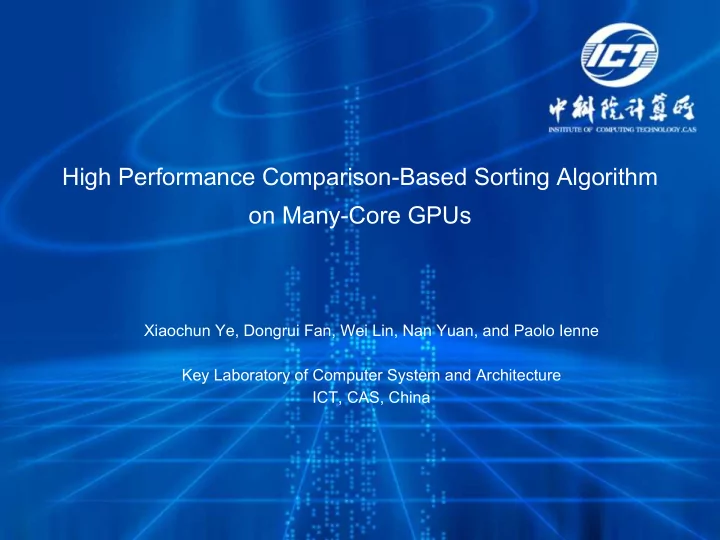

High Performance Comparison-Based Sorting Algorithm on Many-Core GPUs Xiaochun Ye, Dongrui Fan, Wei Lin, Nan Yuan, and Paolo Ienne Key Laboratory of Computer System and Architecture ICT, CAS, China
Outline GPU computation model Our sorting algorithm A new bitonic-based merge sort, named Warpsort Experiment results conclusion
GPU computation model Massively multi-threaded, data-parallel many-core architecture Important features: SIMT execution model Avoid branch divergence Warp-based scheduling implicit hardware synchronization among threads within a warp Access pattern Coalesced vs. non-coalesced
Why merge sort ? Similar case with external sorting Limited shared memory on chip vs. limited main memory Sequential memory access Easy to meet coalesced requirement
Why bitonic-based merge sort ? Massively fine-grained parallelism Because of the relatively high complexity, bitonic network is not good at sorting large arrays Only used to sort small subsequences in our implementation Again, coalesced memory access requirement
Problems in bitonic network naïve implementation Block-based bitonic network One element per thread Some problems in each stage thread n elements produce only n /2 compare-and-swap operations Form both ascending pairs and descending block pairs Between stages synchronization Too many branch divergences and synchronization operations
What we use ? Warp-based bitonic network each bitonic network is assigned to an independent warp, instead of a block Barrier-free, avoid synchronization between stages threads in a warp perform 32 distinct compare-and-swap operations with the same order Avoid branch divergences At least 128 elements per warp And further a complete comparison-based sorting algorithm: GPU-Warpsort
Overview of GPU-Warpsort Divide input seq into small tiles, and each followed by a warp- based bitonic sort Merge, until the parallelism is insufficient. Split into small subsequences Merge, and form the output
Step1: barrier-free bitonic sort divide the input array into equal-sized tiles Each tile is sorted by a warp-based bitonic network 128+ elements per tile to avoid branch divergence No need for __syncthreads() Ascending pairs + descending pairs Use max () and min () to replace if-swap pairs
Step 2: bitonic-based merge sort t -element merge sort Allocate a t -element buffer in shared memory Load the t /2 smallest elements from seq A and B , respectively Merge Output the lower t /2 elements Load the next t /2 smallest elements from A or B t = 8 in this example
Step 3: split into small tiles Problem of merge sort the number of pairs decreases geometrically Can not fit this massively parallel platform Method Divide the large seqs into independent small tiles which satisfy:
Step 3: split into small tiles (cont.) How to get the splitters? Sample the input sequence randomly
Step 4: final merge sort Subsequences (0, i ), (1, i ),…, ( l -1, i ) are merged into S i Then, S 0 , S 1 ,…, S l are assembled into a totally sorted array
Experimental setup Host AMD Opteron880 @ 2.4 GHz, 2GB RAM GPU 9800GTX+, 512 MB Input sequence Key-only and key-value configurations 32-bit keys and values Sequence size: from 1M to 16M elements Distributions Zero, Sorted, Uniform, Bucket, and Gaussian
Performance comparison Mergesort Fastest comparison-based sorting algorithm on GPU (Satish, IPDPS’09) Implementations already compared by Satish are not included Quicksort Cederman, ESA’08 Radixsort Fastest sorting algorithm on GPU (Satish, IPDPS’09) Warpsort Our implementation
Performance results Key-only 70% higher performance than quicksort Key-value 20%+ higher performance than mergesort 30%+ for large sequences (>4M)
Results under different distributions Uniform, Bucket, and Gaussian distribution almost get the same performance Zero distribution is the fastest Not excel on Sorted distribution Load imbalance
Conclusion We present an efficient comparison-based sorting algorithm for many-core GPUs carefully map the tasks to GPU architecture Use warp-based bitonic network to eliminate barriers provide sufficient homogeneous parallel operations for each thread avoid thread idling or thread divergence totally coalesced global memory accesses when fetching and storing the sequence elements The results demonstrate up to 30% higher performance Compared with previous optimized comparison-based algorithms
Thanks
Recommend
More recommend